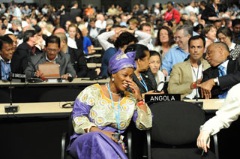A Human Development Framework for CO2 Reductions

|
Due to the disparity of numbers regarding historical CO2 emissions between developed and developing countries, country-specific mitigation efforts discussed in climate negotiations need to comply with the UNFCCC principle of common but differentiated responsibilities [1]. By evaluating the historical dependency (1980 - 2006) between the Human Development Index (HDI) [2] and CO2 emissions per capita from fossil fuels [3], it is possible to statistically determine what level of HDI is usually associated with what level of CO2 emissions. By projecting this relation into the near-future (2050) under three different population scenarios in [4], and assuming that developing nations in the year 2000 are allowed to emit CO2 until a minimum development goal (HDI = 0.8) is reached (afterwards CO2 reduction is mandatory), fair mitigation efforts for developed and developing countries can be obtained with respect to a global target. Following such an approach, about 300 Gt of CO2 between 2000 and 2050 would constitute a historically fair budget to be reserved solely for developing countries [5]. This budget constitutes about one third of the cumulative global budget to keep global mean temperatures below 2 degree increase by 2100 with a 75% chance, as previously calculated by [6]. In addition, country-specific emission pathways of CO2 to comply with global mitigation targets can also be obtained. See example below.

Figure 1: Examples of projected CO2 emissions per capita for selected developed and developing countries in order to keep the 2 degree target (with 75% chances) while reserving a fair emission budget for the development of developing countries. Solid lines stand for the historical emission while the connected circles represent extrapolated emissions when countries follow the reduction scheme proposed in [5]
Although such an approach can be regarded as a step forward in incorporating the fairness dimension in mitigation discussions, some caveats have to be mentioned. For example, it is arguable to use exclusively the HDI as an indicator for the development of a country. Furthermore, unpredictable political decisions, such as massive investments in clean energy, are also not captured. Finally, it should be pointed that the HDI numbers used in this exercise refer to the ones in [2]. Since 2012, the United Nations Development Program (UNDP) slightly altered the methodology to calculate the HDI of countries.
|